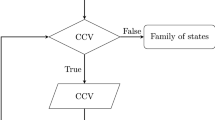Abstract
An N-partite state is considered lazy, if the entropy rate of one subsystem with respect to time is zero under any coupling to the other subsystems. In this paper, we show that all biaxial or purely second rank tensor polarized systems are lazy. Such a system can be produced in the laboratory by the interaction of a spin-1 nuclei with non-zero quadrupole moment like H 2, N 14 with an external quadrupole field found in suitable crystal lattice. We then investigate the ’laziness’(property of the system to be lazy) of N-qubit mixed symmetric separable states and enumerate the conditions for them to be lazy. Further, we study the laziness of direct product states on application of a global and local noisy channels.
Similar content being viewed by others
References
Ferraro, A., Aolita, L., Cucchietti, D., Acin, A.: Phys. Rev. A 81, 052318 (2010)
Rodriguez, C.A., Gen Kimura, H.I., Aspuru-Guzik, A.: Phys .Rev. Lett. 106, 050403 (2011)
Xu, J.: Int. J. Mod. Phys. B 29, 1550121 (2015)
Xu, J.: Int. J. Theor. Phys. 54, 860 (2015)
Fano, U.: Phys. Rev. 90, 577 (1953)
Fano, U.: Rev. Mod. Phys. 29, 74 (1957)
Fano, U.: Rev. Mod. Phys. 55, 855 (1983)
Fano, U.: Natl Bur. Stan. Rep. 1214 (1951)
Ramachandran, G., Ravishankar, V., Sandhya, S.N., Sirsi, S.: J. Phys. G: Nucl. Phys. 13, L271 (1987)
Ramachandran, G., Ravishankar, V.: J. Phys. G: Nucl. Phys. 12 (1986)
Yu, T., Eberly, J.H.: Opt. Commun. 264(2), 393 (2006)
Bogdanov, Y.I., Bantyush, B.I., Chernyavskiy, A.Y., Lukichev, V.F., Orlikovsky, A.A.: Russ. Microelectron. 44, 225 (2015)
Author information
Authors and Affiliations
Corresponding author
Appendix
Appendix
A qubit can be represented by {|0〉,|1〉} or \( \{|\frac {1}{2}, \frac {1}{2}\rangle , |\frac {1}{2}, \frac {-1}{2} \rangle \}\) or {|↑〉,|↓〉}. Any 2-qubit state resides in 22-dimensional Hilbert space and the most convenient basis set in this Hilbert space is the computational basis set { |↑↑〉,|↑↓〉,|↓↑〉,|↓↓〉}. One can also choose the basis set {|11〉 = |↑↑〉, \(|10\rangle =\frac {|\uparrow \downarrow \rangle +|\downarrow \uparrow \rangle }{\sqrt 2}, |1-1\rangle =|\downarrow \downarrow \rangle , |00 \rangle = \frac {|\uparrow \downarrow \rangle -|\downarrow \uparrow \rangle }{\sqrt 2}\}\). Note that the first three bases, known as the triplets in the angular momentum theory, are permutationally symmetric and corresponds to the total angular momentum j = 1 and the last one is permutationally anti-symmetric and corresponds to j = 0. CG decomposition is thus given by 2 ⊗ 2 = 3 ⊕ 1.
The unitary transformation which connects computational basis set to the angular momentum basis set is,
The elements of unitary transformation are the Clebsch-Gordan coefficients. It is very well known in the angular momentum theory that the Clebsch-Gordan addition of two angular momenta j 1 and j 2 is given by,
where j = |j 1 − j 2| to (j 1 + j 2) and m = −j to + j with the constraints m = m 1 + m 2. Explicitly, for j 1 = 1/2 and j 2 = 1/2,
Thus, 2-qubit symmetric state has one-to-one correspondence with a spin-1 state. Similarly, for a three qubit state, Clebsch-Gordan decomposition is given by 2 ⊗ 2 ⊗ 2 = 4 ⊕ 2 ⊕ 2 out of which 4 dimensional space is totally symmetric. Thus, a 3-qubit symmetric state has one-to-one correspondence with a spin-\(\frac {3}{2}\) state.
Number of qubits N | \(j=\frac {N}{2}\) | \(j=\!\frac {N}{2}-1\) | \(j\,=\,\frac {N}{2}-2\) | \(j\,=\,\frac {N}{2}-3\) | \(j\,=\,\frac {N}{2}-4\) | \(j\,=\,\frac {N}{2}-5\) |
|---|---|---|---|---|---|---|
1 | 1 | – | – | – | – | – |
2 | 1 | 1 | – | – | – | – |
3 | 1 | 2 | – | – | – | – |
4 | 1 | 3 | 2 | – | – | – |
5 | 1 | 4 | 5 | – | – | – |
6 | 1 | 5 | 9 | 5 | – | – |
7 | 1 | 6 | 14 | 14 | – | – |
8 | 1 | 7 | 20 | 28 | 14 | – |
9 | 1 | 8 | 27 | 48 | 42 | – |
10 | 1 | 9 | 35 | 75 | 90 | 42 |
The above table shows the number of representations for N = 1⋯10 qubits. \(j=\frac {N}{2}\) has the largest dimension and corresponds to the totally symmetric representation. Thus for an N-qubit state, there exit an N + 1 dimensional subspace which is totally symmetric. Therefore there is a one to one correspondance between Hilbert space of spin-j (\(j=\frac {N}{2}\)) system and the symmetric subspace. The smallest dimension of the representation i.e j = 0 for even number of qubits, \(j=\frac {1}{2}\) for odd number of qubits consists of totally antisymmetric as well as mixed symmetric representation.
Rights and permissions
About this article
Cite this article
S P, S., Sirsi, S. Laziness of Symmetric and Separable States. Int J Theor Phys 56, 2221–2230 (2017). https://doi.org/10.1007/s10773-017-3369-8
Received:
Accepted:
Published:
Issue Date:
DOI: https://doi.org/10.1007/s10773-017-3369-8



